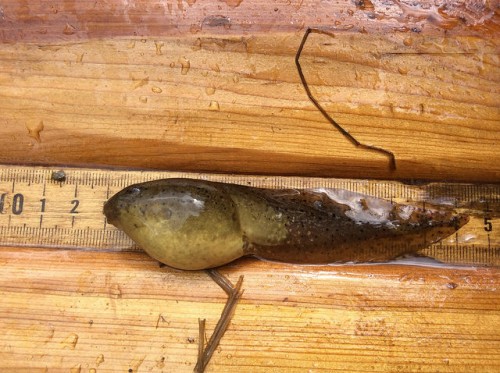Lithobates catesbeianus
Identification Tips:
Adults
• Largest frog in North America (to 20 cm excluding legs)
• Eardrum as large or larger than the eye
• No ridges along sides of back
• Prominent fold extends from rear of each eye to top of foreleg, wrapping closely around the eardrum
• Webbing on hind feet extends to end all but one toe
• Throat yellow in breeding season
Tadpoles
• Large size (some >10 cm)
• Well defined but very small black spots on upper half of tail and head
• Belly often yellowish, especially on larger individuals
Egg Masses
• Eggs black above, whitish below, in flat gelatinous masses that may exceed 1 m in diameter
Conservation Status:
| British Columbia | Canada | Natureserve | |
| COSEWIC | Species at Risk Act | ||
| Introduced Species | Not Assessed | None | G5 |
Life History:
• Breeds in mid-summer; late June to July in Fraser Valley
• Reach sexual maturity several years after metamorphosis
• May migrate seasonally between habitats several kilometres apart
• Adults eat a variety of invertebrates and small vertebrates; anything that can be captured and swallowed.
• Tadpoles eat algae, plants, organic debris and very small invertebrates.
• Overwinter at the bottom of pools or under cover in or near water.
Habitat:
• Ponds, swamps, warm lakes
• Tolerate brackish water
• Tadpoles overwinter at least once
Range:
British Columbia
• Fraser Valley and southern Vancouver Island
Global
• Native to eastern North America from Nova Scotia West through Great Lakes and south through central and eastern United States to northeastern Mexico
• Introduced feral populations in Western North America, Carribean Islands, Europe, Britain, Hawaii and Japan
Comments:
• Bad news: Implicated in the extinction of numerous native fish and amphibians from the many areas to which it has been introduced.
––––––
Primary Information Sources:
Efauna BC: http://ibis.geog.ubc.ca/biodiversity/efauna/
BC Conservation Data Centre: http://a100.gov.bc.ca/pub/eswp/


